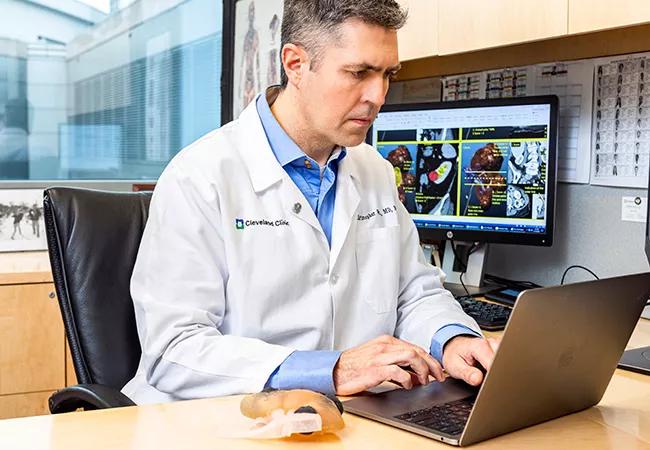
Innovation is at the cornerstone for care in Cleveland Clinic’s Department of Urology, and it’s enabling experts to deliver more personalized approaches to patients. From developing new ways to screen for and treat genitourinary cancers to leveraging robotic and artificial intelligence platforms — our experts are transforming how urologic conditions are diagnosed and treated.
Advertisement
Cleveland Clinic is a non-profit academic medical center. Advertising on our site helps support our mission. We do not endorse non-Cleveland Clinic products or services. Policy
“In the United States, tens of thousands of patients may be unnecessarily undergoing surgery or receiving treatment for kidney cancer because the benign tumor mimics that of a malignant one on computed tomography (CT) imaging,” explains Christopher Weight, MD, Center Director for Urologic Oncology.
To address potential overtreatment, Dr. Weight and his colleagues are utilizing artificial intelligence-based segmentation to recognize pathologic characteristics of the tumor and its surrounding anatomy. Often disease features are too complex and subjective for large-scale human interpretation. However, tapping into AI imaging technologies that integrate data from CT scans segments with nephrectomy scores could prognosticate disease at a high level.
“We hope that additional investigation into this work will provide an even more personalized approach to kidney cancer care,” he says.
Determining whether a patient should undergo partial nephrectomy versus a more aggressive radical nephrectomy is a big question in the field. Urologic oncologist Steven Campbell, MD, PhD, and colleagues are using semi-automated imaging software to optimize management.
The technology automatically measures renal parenchymal volume in the kidney with the tumor and in the contralateral kidney. “That differential of parenchymal volume provides a split renal function that’s as accurate as a nuclear renal scan, and, in our studies, has actually proven to be more accurate,” he says.
Single-port (SP) robotic surgery is a new generation of robot that is enabling further regionalization of urologic surgery. The surgeon introduces a camera and three other narrow-profile instruments through one cannula; thereby, avoiding unnecessary involvement of other anatomy and leading to improved recovery outcomes.
Advertisement
Over the last several years, the Cleveland Clinic team has pioneered numerous applications using the SP robotic system to assist with robotic partial nephrectomy for removal of cancerous kidney tumors through a small incision outside the bowel sac, called the peritoneum. Additional complex robotic procedures applied the SP approach, such as the extraperitoneal robotic SP kidney transplant and autotransplant, nephrectomy, pyeloplasty, prostate surgery, including transvesical and extraperitoneal prostatectomy, cystectomy, and urinary tract reconstruction.
SP is also appealing for use in pediatric patients because it requires a minimal incision site and enables a retroperitoneal approach. The incision, called mini-Pfannansteil is performed low in the pelvis, away from the abdominal muscle, a cosmetically appealing option for younger patients.
Jihad Kaouk, MD, Director of the Center for Advanced Robotics and Image-Guided Surgery, says there is still untapped potential for robotic surgery, adding that we can look forward to the “smart” application of the system next: “moving the robot from an extension to my hands and eyes, to become a partner in the surgery under human control.”
“Our focus on innovation will keep moving and evolving patient care into the future,” he says.
Advertisement
Advertisement

Pediatric urologists lead quality improvement initiative, author systemwide guideline

Fixed-dose single-pill combinations and future therapies

Reproductive urologists publish a contemporary review to guide practice

Two recent cases show favorable pain and cosmesis outcomes

Meta-analysis assesses outcomes in adolescent age vs. mid-adulthood

Proteinuria reduction remains the most important treatment target.

IgA nephropathy is a relatively common autoimmune glomerular disease that can be diagnosed only by biopsy

Oncologic and functional outcomes are promising, but selection is key